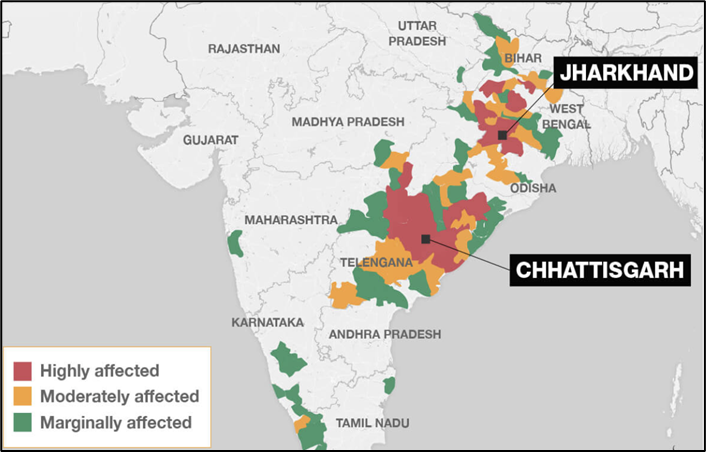Mains Daily Question
April 27, 2023
What do you understand by Left Wing Extremism (LWE)? Elucidate the major factors behind the occurrence of LWE and the governmental action to root out the menace.
Approach:
Introduction: Define Left Wing Extremism
Body:
- Give a few points on major factors behind LWE
- Give a few points on steps taken by the government
Conclusion: Conclude by telling about the success of the government in reducing LWE-related violent incidents.
Answer:
Left-wing extremism in India refers to the ongoing Maoist insurgency in parts of India, also known as Naxalism. It is a far-left radical communist movement that began in 1967 in the village of Naxalbari, West Bengal. Its aim is of overthrowing current capitalist systems and replacing them with communist or socialist societies.
The movement has since spread to several other states including Chhattisgarh, Jharkhand, Bihar, Odisha, and Andhra Pradesh.
Major Factors Behind LWE:
- Tribal dissatisfaction arises from the Forest (Conservation) Act of 1980, which prohibits tribes who rely on forest resources for their livelihood from even harvesting bark.
- The implementation of development projects, mining operations, and other factors has resulted in significant displacement of tribal populations in states affected by LWE.
- Vulnerable individuals lacking sustainable means of support become susceptible to joining the Naxalite movement. Maoists exploit this situation by providing weapons, ammunition, and financial assistance to these individuals.
- The country's socio-economic system exhibits gaps wherein the government measures its success based on the number of violent attacks in Naxal-affected regions, rather than focusing on developmental efforts.
- Insufficient technical intelligence hampers effective strategies against Naxalism. Challenges such as inadequate infrastructure, including the lack of proper communication networks in some villages, impede actions against Naxalites.
- Following the police's control over a region, the administration often fails to deliver essential services to the local population, leaving them without the necessary support.
- There is confusion regarding how to approach Naxalism, whether as a social issue or a security threat. State governments tend to perceive Naxalism as the responsibility of the central government, resulting in a lack of proactive initiatives to combat it.
Government’s approach against Naxalism:
- The commencement of "Operation Green Hunt" took place in 2010, involving a significant deployment of security forces in Naxal-affected regions.
- The aspirational Districts Programme aims to address LWE comprehensively. This includes addressing security concerns, promoting development, safeguarding the rights and entitlements of local communities, improving governance, and managing public perception.
- The Ministry of Home Affairs (MHA) initiated "Operation SAMADHAN" to tackle the Naxal problem. SAMADHAN stands for Smart leadership, Aggressive strategy, Motivation and training, Actionable intelligence, Dashboard Based KPIs (key performance indicators) and KRAs (key result areas), Harnessing technology, Action plan for each theatre, and No access to financing.
- The MHA has recommended employing technological interventions such as weapon trackers and biometrics for smart guns. It also suggests assigning Unique Identification numbers (UIDs) to gelatine sticks and explosives.
- To enhance coordination and intelligence sharing, Joint Task Forces are to be established for operations along inter-state boundaries.
Various measures taken by the government address both security and development issues, such as the Aspirational District Program. The occurrence of violent incidents related to left-wing extremism in India has decreased in recent years. Consequently, the Indian Home Ministry has removed several districts from the list of those affected by left-wing extremism.


